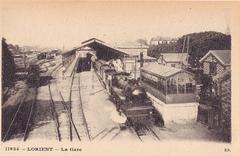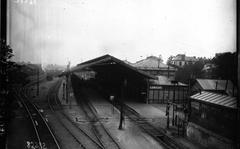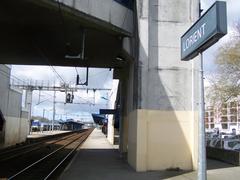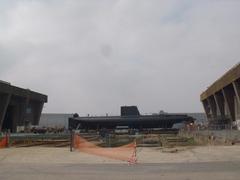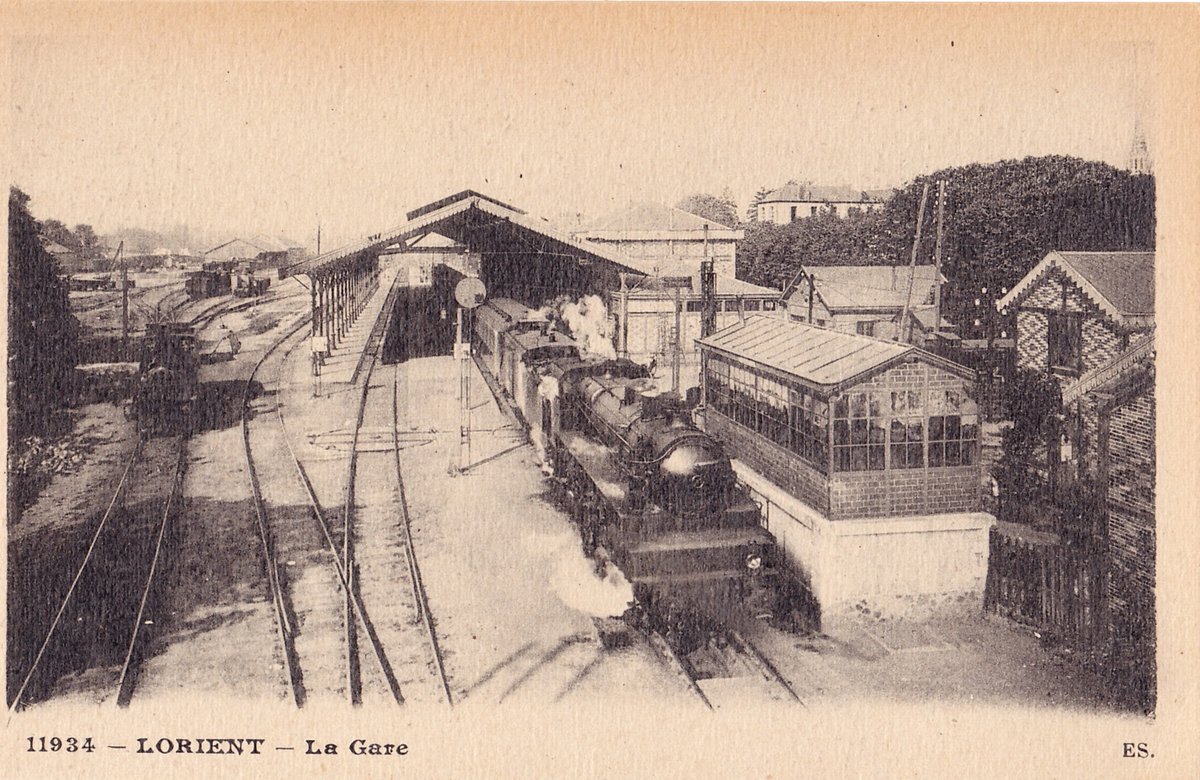
Gare de Lorient Visiting Hours, Tickets & Travel Guide
Date: 15/06/2025
Introduction: Gare de Lorient – Brittany’s Modern Maritime Gateway
Situated in the heart of Brittany’s Morbihan department, Gare de Lorient is more than a transport hub—it is a testament to Lorient’s resilience, architectural innovation, and maritime heritage. Since opening in 1862, the station has evolved from a vital 19th-century rail link into a contemporary landmark, offering high-speed connections to Paris and regional cities, while serving as a striking symbol of urban regeneration. Lorient’s station is not only central to the city’s daily life but also connects visitors to significant cultural sites such as the Cité de la Voile Éric Tabarly and the WWII Submarine Base. This guide provides essential details on visiting hours, ticketing, accessibility, local attractions, and travel advice to help you make the most of your journey through southern Brittany (Wikipedia; Lorient Agglo; Tourisme Bretagne).
Quick Reference
- [Opening Hours: Generally 5:00 or 5:30 AM – 11:30 PM daily (confirm on SNCF Connect for updates)](#opening-hours:-generally-5:00-or-5:30-am-–-11:30-pm-daily-(confirm-on-sncf-connect-for-updates))
- Ticket Counters: 6:00 AM – 9:00 PM; ticket machines available 24/7
- Accessibility: Fully accessible (elevators, ramps, tactile guides, assistance available)
- Transport Links: TGV, Intercités, TER, OuiGo, urban buses, regional coaches, ferry shuttles, bike rental
- Key Attractions Nearby: Cité de la Voile Éric Tabarly, WWII Submarine Base, Port de Plaisance, Lorient City Center
History and Architectural Evolution
19th–Early 20th Century: Foundations and Growth
Gare de Lorient opened in 1862, quickly establishing itself as the primary rail link between Lorient and major French cities. Its early location north of the tracks facilitated trade and travel, making Lorient a leading station in Morbihan by 1912, with the highest departure revenues among 30 regional stations (Wikipedia). This growth mirrored Lorient’s emergence as a major port and commercial center.
WWII Destruction and Post-War Renewal
Lorient’s strategic importance made it a key target during WWII. Allied bombings in 1943 destroyed the original station and much of the city (Wikipedia). Reconstruction was led by architect Georges Tourry and culminated in the 1966 reopening of a functional, modernist station—reflecting the spirit of postwar urban renewal.
High-Speed Era and 21st-Century Transformation
The arrival of the high-speed TGV network and the “Bretagne à Grande Vitesse” project in the 2010s prompted a complete overhaul. Anticipating an increase in annual passengers from 1.4 to 2.5 million, a multimodal redevelopment was undertaken by AREP Group, culminating in the 2017 opening of Gare de Lorient Bretagne Sud (Architectures Jidipi; Chroniques Architecture).
Contemporary Design and Urban Integration
The new station, inspired by ship hulls, boasts innovative timber and glass architecture—a nod to Lorient’s shipbuilding heritage (Le Moniteur; ArchDaily). A timber pedestrian bridge unites north and south, improving urban flow and multimodal connections. The station’s orientation and design invite city life inward, supporting Lorient’s “Odyssée” district—a 15-hectare urban project blending housing, offices, and public spaces.
Visiting Hours and Ticketing
- Station Opening: 5:00 AM – 11:30 PM (some sources list 5:30 AM; check SNCF Connect for daily updates)
- Ticket Counters: 6:00 AM – 9:00 PM
- Ticket Machines: 24/7
- Online Booking: SNCF Connect
- Ticket Types: TGV, TER, Intercités, OuiGo, and discount cards
- Advance Booking: Strongly advised for TGV and OuiGo, especially during festivals or summer
Accessibility and Services
Gare de Lorient is equipped for all:
- Step-free access, elevators, tactile paving
- Accessible restrooms and reserved seating
- Assistance desk (request in advance for mobility support)
- Clear bilingual signage (French/English)
- Luggage lockers and free Wi-Fi
- Shops, cafés, waiting lounges, and a tourism kiosk
Transport Connections
- High-Speed Rail: Direct TGV to Paris Montparnasse (~3 hours), Quimper, Lille
- Regional Rail (TER): Frequent services to Vannes, Rennes, Nantes, Quimper, Brest (Lorient Bretagne Sud Tourisme)
- Urban Buses: IZILO and BreizhGo networks connect city center, suburbs, and regional towns (IziLo)
- Ferry Transfers: Bus line 11 links the station to Gare Maritime (for ferries to Île de Groix via BreizhGo)
- Cycling: Bike rentals (Maison du Vélo), free and secure bike parking (Lorient Vélo)
- Parking: Paid lots and drop-off points adjacent to the station
Nearby Attractions
- Cité de la Voile Éric Tabarly: Interactive maritime museum on Brittany’s sailing legacy
- Lorient Submarine Base: WWII heritage site and museum
- Port de Plaisance: Waterfront promenade, cafés, and markets
- Lorient City Center: Shops, restaurants, art-deco and modernist architecture
- Citadel of Port-Louis: 17th-century fortress with panoramic views
Travel Tips
- Book tickets and accommodation early during summer and festival periods (notably the Festival Interceltique de Lorient each August)
- Use lockers for luggage-free city exploration
- Pick up maps and advice at the tourism kiosk or Maison des Mobilités
- Download the Audiala app for real-time updates and local tips
- Bring a waterproof jacket—Brittany’s weather is famously changeable
- Try local seafood and explore markets for a taste of Breton culture
Frequently Asked Questions (FAQ)
Q: What are Gare de Lorient’s opening hours?
A: Generally 5:00 or 5:30 AM to 11:30 PM; ticket counters 6:00 AM to 9:00 PM.
Q: Can I buy tickets at the station?
A: Yes, at staffed counters, ticket machines, or online via SNCF Connect.
Q: Is the station accessible for travelers with disabilities?
A: Fully accessible with elevators, ramps, tactile guides, and staff assistance.
Q: How do I get to Île de Groix?
A: Take bus line 11 from the station to Gare Maritime for ferries to the island (BreizhGo).
Q: Are guided tours available?
A: While the station itself doesn’t offer tours, the Lorient tourist office arranges city and maritime heritage tours.
Plan Your Visit
For the latest schedules, ticketing, and accessibility information, consult the following resources:
- SNCF Gare de Lorient
- Lorient Tourisme
- IZILO Urban Transport
- BreizhGo Ferries
- Brittany Tourism – Lorient
Final Word
Gare de Lorient stands as a living monument to Brittany’s past and its innovative future—blending historical significance, sustainable design, and outstanding connectivity. Whether you’re passing through, exploring Lorient’s port and museums, or embarking on a journey across Brittany, the station is your ideal starting point. Download the Audiala app, follow us for travel inspiration, and enjoy your stay in Lorient!
